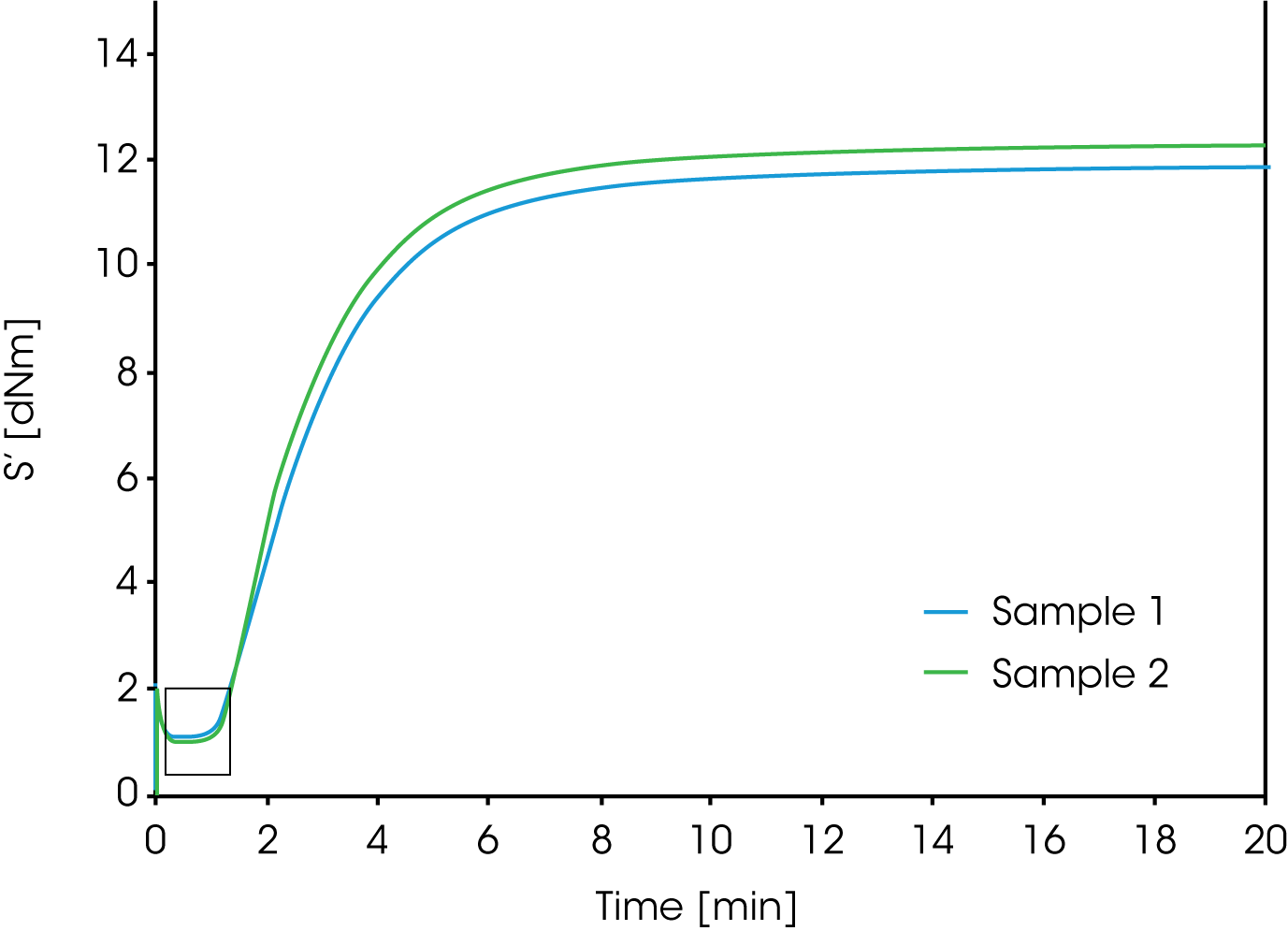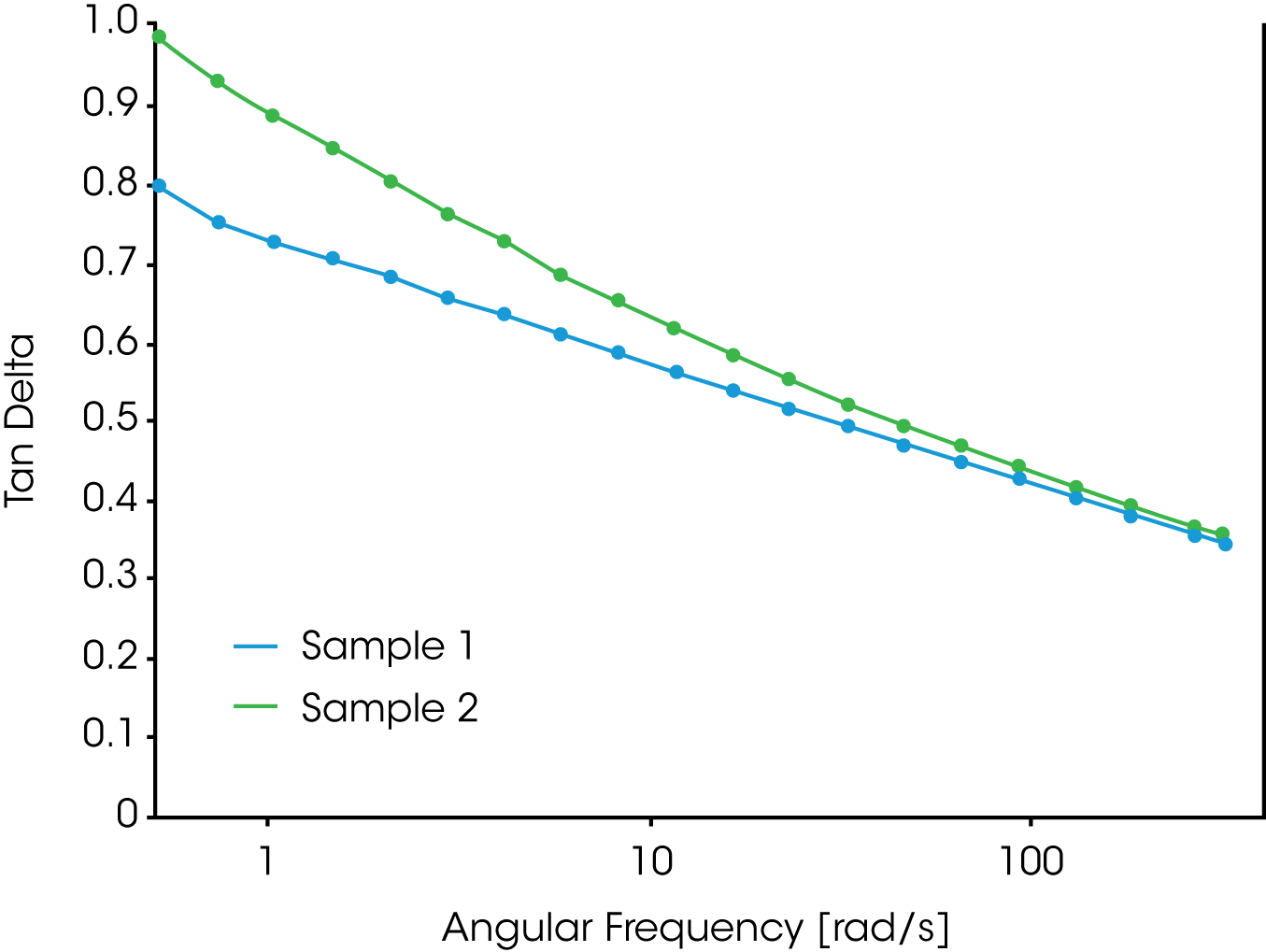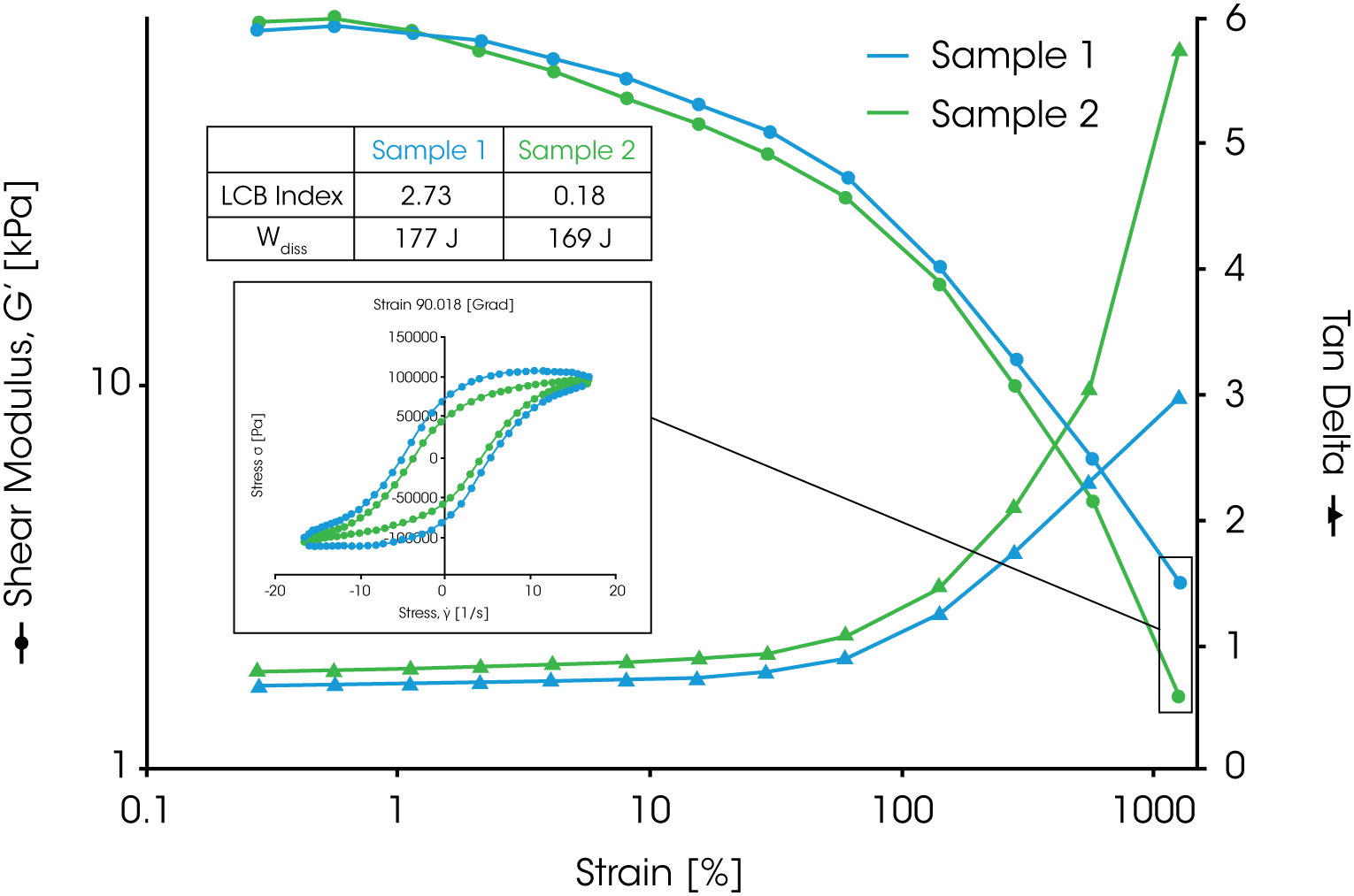Keywords: Rubber, Elasticity, Extrusion, RPA
RT005
Background
The Rubber Process Analyzer (RPA) from TA Instruments | Waters can be used to troubleshoot processing issues by measuring the viscoelastic properties of the raw polymer material and rubber compounds. Differences in viscoelastic properties1-3 can lead to difficulties within the production process. In this note, we present a case study where an RPA was utilized to troubleshoot a processing problem where extrusion instabilities were experienced. We will compare one batch of material that processed normally to another batch that demonstrated scorch problems in the extruder, resulting in a product with orange skin or orange peel texture. Both batches of rubber were tested with the moving die rheometer (MDR), with representative curves shown in Figure 1. The cure curves show that sample 1, which exhibited scorch behavior during the manufacturing process, cured more slowly than sample 2, which showed no processing issues. These results contradict the processing behavior on the production floor. The MDR data would lead one to believe that sample 2 would experience scorch problems since it cures faster. However, the opposite was true. In addition, both curves show a similar minimum torque around 1 dNm, indicating that these two samples would process similarly. The results from the MDR tests were unable to distinguish the differences between the materials and did not provide the information needed to identify the root cause of the processing issues.
This note will demonstrate the use of the RPA to characterize the material properties of the two rubber compounds, and the data further used to troubleshoot the extrusion instabilities.
Method
The RPA elite (TA Instruments, New Castle, DE) is an advanced, rotorless rotational shear rheometer dedicated to the complete viscoelastic characterization of polymers, rubber, and rubber compounds at all stages of manufacturing. The RPA elite provides invaluable data related to the viscoelastic behavior of materials in the pre-cure state, through the curing process, and in situ cured state. Standard rubber testing on the MDR and Mooney viscometer does not provide additional viscoelastic characterization that is essential to optimizing processing parameters and troubleshooting many processing issues. Samples are compressed and sealed in a biconical die under high pressure, as is standard in the rubber industry. This design results in a closed testing cavity which prevents melt fracture at the sample edge, and compressive forces to prevent sample slippage during testing.
Both features are imperative for obtaining accurate data in the non-linear regime, particularly during large amplitude oscillatory strain (LAOS) testing. The viscoelastic properties of the samples measured in this note were obtained on the RPA using standard oscillation testing, such as frequency sweeps and strain sweeps. Frequency sweeps were performed from 0.0628 rad/s to 314 rad/s or 0.01 Hz to 50 Hz using an appropriate strain amplitude of 0.1 degrees, which was within the linear viscoelastic regime of the testing specimen, while strain sweeps were performed from 0.1° to 90° degrees of arc using an appropriate frequency of 1 Hz. Approximately 5.5 grams of material (+\- 5%) was utilized and compressed in the testing cavity using a clamping pressure of 4.5 bar and a temperature of 90° C. Samples were allowed to relax for 10-15 minutes in the testing cavity before viscoelastic measurements were performed in order to allow ample time for any internal stresses experienced during the loading process to dissipate.

Viscoelastic Data
Frequency sweep tests on the RPA were performed to characterize both samples and correlate differences in viscoelasticity1-3 with their processing behavior. The complex viscosity is shown as a function of angular frequency in Figure 2. Both samples show shear thinning behavior, with the complex viscosity decreasing as the angular frequency, and consequently shear rate, increase.
However, sample 1 is shown to have a slightly lower viscosity at elevated frequencies which corresponds to high shear rates. Materials experience high shear rates during processing steps such as mixing, milling, and extrusion. Conversely, sample 1 also shows a higher viscosity at the low angular frequencies. Material properties at low angular frequencies is representative of material behavior at low shear rates, such as exiting an extruder, sitting on a shelf, or filling a mold. A higher viscosity typically corresponds to a stronger resistance to flow, usually due to a higher degree of elasticity. The difference in elasticity between the samples is highlighted in Figure 3, by replotting the results of the frequency sweep as tangent delta vs. frequency. The tangent delta between both samples is significantly different, with sample 1 showing a value of 0.725 at 1 rad/s compared to 0.89 for sample 2. These tangent delta results indicate that sample 1 is more elastic compared to sample 2. The increase in elasticity can be attributed to higher molecular weight or the presence of long chain branching.


Further analysis included a large amplitude oscillatory shear (LAOS) test on both samples where the strain was varied from 0.3% to over 1000% strain. The storage modulus (G’) and the tangent delta for both samples are shown as a function of strain percent in Figure 4. Sample 1 and 2 have similar viscoelastic behavior at low strains but at higher strains in the non-linear regime, where the modulus decreases, the viscoelastic responses begin to deviate. The storage modulus (G’) for sample 1 is much higher than sample 2, indicating a stronger elastic structure within the material. The higher storage modulus (G’) equates to a stronger microstructure, usually as a result of higher molecular weight, polymer rigidity, and additive interactions.4-6 This is also corroborated by the tangent delta signal, with sample 1 showing a lower tangent delta overall which corresponds to a larger degree of elasticity. The data at 90° of arc, or strain percent of 1255%, can be recast by plotting the transient shear stress against the shear rate in the Lissajous plot (inset, Figure 4). The long chain branching index can be calculated from the Lissajous plot. Both Lissajous plots show a lack of secondary loops, indicating the presences of long chain branching. This is confirmed with positive long chain branching index values of 2.73 and 0.18 for sample 1 and 2, respectively. The long chain branching index indicates that sample 1 has a higher degree of long chain branching compared to sample 2, which was confirmed through the tangent delta value in the frequency and amplitude spectra. Recall, sample 1 demonstrated a lower tangent delta which corresponds to a higher degree of elasticity.
The presence of long chain branching contributes to the elastic character of the material. Usually the presence of long chain branching improves processability, however, process engineers saw challenges and scorching problems with sample 1 despite the higher degree of long chain branching. The work dissipated during oscillation and shear can be calculated from the Lissajous plot by measuring the area within the ellipse when plotting transient stress against strain. This work is associated with viscous heating; this heat must be removed from the material or it will result in a local temperature rise. Analysis at 90° of arc, or strain percent of 1255%, shows the work dissipated to be 177 J and 169 J for sample 1 and 2, respectively. Compared to sample 2, sample 1 shows a larger amount of energy dissipated at high shear which is akin to the shear rates experienced within the extruder. The larger amount of energy dissipation could cause local temperature increase within the sample as it is sheared within the extruder.
Despite the MDR cure curve showing sample 1 would cure more slowly, local temperature elevations within the sample as a result of energy dissipation from the induced shear in the extruder could result in scorching of sample 1 during the extrusion process. The RPA was able to quantify differences between the two rubber compounds and help process engineers optimize their processing conditions by decreasing the extruder speed and then re-evaluating the compound formulation.

Conclusion
The RPA can be used to measure the viscoelastic properties of rubber compounds and raw polymers as a function of shear rate and deflection, which are directly linked to flow and processing behavior. Data obtained from frequency sweeps and amplitude sweeps can be used to identify differences in polymer architecture, such as the presence of long chain branching and variations in molecular weight and molecular weight distribution. Testing on the RPA was able to distinguish differences between two batches where the standard Mooney and MDR tests failed. Testing data from an RPA can be used to identify variations in polymer architecture, providing insight to the flow behavior so production parameters can be optimized in advance and waste can be reduced.
References
- Barnes, H. A. “An Introduction to Rheology”, Elsevier, 1989.
- Macosko, C. W. “Rheology: Principles, Measurements and Applications” VCH Publishers, New York, 1994.
- Tschoegl, N. W. “The Phenomenological Theory of Linear Viscoelastic Behavior”, Chapter 9, pages 443-483. Springer-Verlag, 1989.
- Ewoldt, R.H. & McKinley, G.H. Rheol Acta (2010) 49: 213. https://doi.org/10.1007/s00397-009-0408-2
- Stadler FJ, Leygue A, Burhin H, Bailly C (2008) The potential of large amplitude oscillatory shear to gain an insight into the long-chain branching structure of polymers. In: The 235th ACS national meeting, polymer preprints ACS, vol 49. New Orleans, LA, USA, pp 121–122
- Burhin HG, Bailly C, Keunings R, Rossion N, Leygue A, Pawlowski H (2008) A study of polymer architecture with FT-rheology and large amplitude oscillatory shear (LAOS). In: XV international congress on Rheology: The Society of Rheology 80th annual meeting, Monterey (California), The Society of Rheology, abstract booklet, EM18
Acknowledgement
Click here to download the printable version of this application note.

